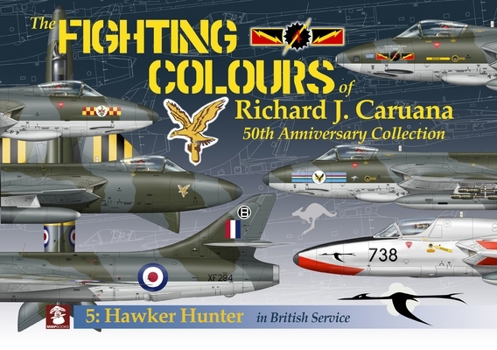The Fighting Colours of Richard J. Caruana: 50th Anniversary Collection. 5: Hawker Hunter in British Service
Call it elegance, call it grace, or even beauty; Hawker's Hunter was the last of a breed of aircraft where one of the rules of thumb in design philosophy was 'if it looks right, it will fly right'. No computer gurus were around at that time, able to run simulated test runs on the desktop. It all had to be done by pencil and slide-rule. Richard J. Caruana describes and illustrates this Hawker thoroughbred, with a selection of some of the most colourful schemes sported by this fighter.
Hawker's Chief Designer, Sir Sydney Camm found little inspiration in the official specifications as outlined in F.43/46 and gave birth to a completely different design concept under the designation of P.1067, flexible enough to accept different power plants. This resulted in the Mk. 1 and Mk. 4 being powered by the Rolls-Royce Avon, the Mk. 2 and Mk. 5 being powered by the Armstrong Whitworth Sapphire. This dual use of power plants probably saved the Hunter from oblivion, as had happened to the troublesome Sapphire of the Supermarine Swift.
It was, however, with the arrival of the Hunter Mk. 6 that a true fighter aircraft was born. The revised and strengthened wings could carry more fuel in underwing tanks, giving the Hunter longer legs, together with the possibility of carrying bombs and rockets with the introduction of the Mk. 9 ground attack version.
Hawker's Chief Designer, Sir Sydney Camm found little inspiration in the official specifications as outlined in F.43/46 and gave birth to a completely different design concept under the designation of P.1067, flexible enough to accept different power plants. This resulted in the Mk. 1 and Mk. 4 being powered by the Rolls-Royce Avon, the Mk. 2 and Mk. 5 being powered by the Armstrong Whitworth Sapphire. This dual use of power plants probably saved the Hunter from oblivion, as had happened to the troublesome Sapphire of the Supermarine Swift.
It was, however, with the arrival of the Hunter Mk. 6 that a true fighter aircraft was born. The revised and strengthened wings could carry more fuel in underwing tanks, giving the Hunter longer legs, together with the possibility of carrying bombs and rockets with the introduction of the Mk. 9 ground attack version.
Format:Paperback
Language:English
ISBN:8367227921
ISBN13:9788367227926
Release Date:March 2025
Publisher:MMP
Length:54 Pages
Related Subjects
HistoryCustomer Reviews
0 rating





